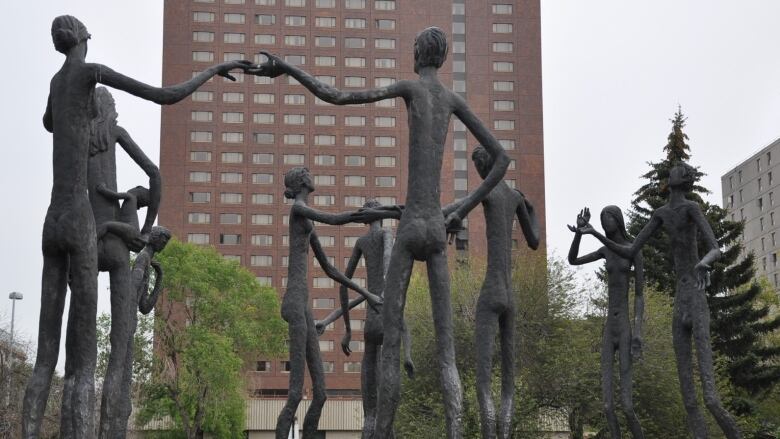How 'disgraceful' naked Brotherhood of Mankind statues became a Calgary icon
'People were shocked and appalled,' says city's culture manager

If you've spent any time downtown, you've probably seen The Brotherhood of Mankind sculptures a group of ten6.5-metre tall aluminum figures making a circle near the old Calgary Board of Education building.
Since their installation in 1968 at the corner of 1st Street and 6th Avenue S.E., the looming figures also known as The Family of Manhave become a landmark in the downtown and a minor tourist attraction in our city.
Love them or hate them, these sculptures, grouped like a family playing together, stand tall throughout the changing seasons.
They're a symbol we associate with the city. They're even the logo for the Calgary Board of Education.
But, Brotherhood of Mankind isn't originally from here.
It was created by Spanish artist Mario Armengol as part of the British Pavilion for the Montreal Expo in 1967.
- You can see The Brotherhoodof Mankind in its original home at the Expo '67 British Pavilion in this Youtube video at about 2:10
Accidental design
While it looks like a bighappy family playing in the park, Calgary art curator Katherine Ylitalo says that's by accident rather than design.
When the figures were first set up, the pieces weren't in the circle formation we see today. Rather, they were spread out as part of an exhibit called Britain in the World.

The figures suggested the dominance of man and stood next to what the Brits determined were their "gifts" to the modern worldthings like language, governmental systems, law and traditions.
After their Expo showing, Brotherhood of Mankind was bought at auction by a businessman and benefactor, who then donated it to the City of Calgary for tax purposes.
And so the figures were crated up and shipped here, where, Ylitalo says, they arrived on a truck and nobody had any directions about how to put them together.
So city staff were left to figure out how to set up the figures and ultimately chose the circle formation we know today.
"And now we even think that they relate to each other," she says. "We think one is a female and has some sort of relationship with another. It was nothing the artist ever thought of. We've constructed this whole narrative."
Shocked and appalled
While almost iconic now, there were a lot of critics when the sculptures were first unveiled.
"They're naked. This was apparently a source of much anguish when it was originally installed. And people were shocked and appalled and thought it was disgraceful," says Sarah Iley, the City of Calgary's Manager of Culture.
But, as time passed and people became used to it, opinions changed.
"Our conservation people were cleaning it up this summer, washing down the bronze [...] And we had a couple of pictures on our Facebook page, and people were commenting about how much they love it and they remember when their parents were mad when it came in."
Since then, Brotherhood of Mankind has seen more than 40 years' worth of changes in Calgary's downtown core.
"There's a real sense of attachment that people have grown up with that piece and it's very much a part of the fabric of Calgary," says Iley.

Calgary at a Crossroads is CBC Calgary's special focus on life in our city during the downturn. A look at Calgary's culture, identity and what it means to be Calgarian. Read more stories from the series at Calgary at a Crossroads.













_(720p).jpg)


 OFFICIAL HD MUSIC VIDEO.jpg)
.jpg)



























































































